Scientists’ $50 billion mission to stop Antarctica’s ‘doomsday glacier’ from melting and destroying the world
John Moore is on a mission to slow the melting of the world’s widest glacier, nicknamed the ‘doomsday glacier’ because of the devastation it could cause on the world.
The 74,000-square-kilometer Thwaites Glacier, located on the western edge of Antarctica, is losing about 50 billion tons more ice than it gains in new snowfall
Professor Moore told DailyMail.com that he and his colleagues want to stop the glacier’s retreat by placing a 100-kilometre-long curtain in front of it to prevent warm ocean waters from melting its base.
The melting alone contributes about four percent to global sea level rise, and if it were to melt completely, it would raise sea levels around the world by as much as 3 meters – and so it has been given its ominous nickname.
The Thwaites Glacier has proven particularly vulnerable to climate change and is melting faster every year. If the Earth continues to warm and the glacier melts completely, this could raise sea levels by as much as three meters.
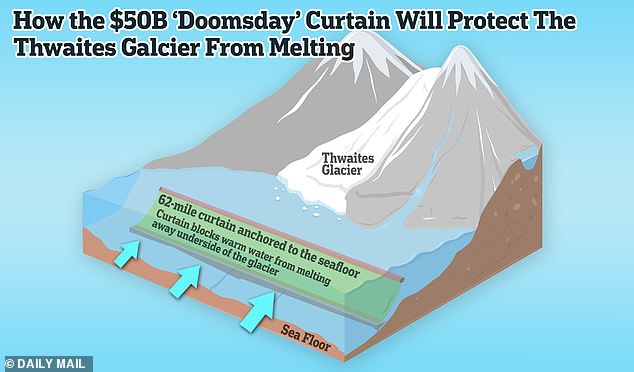
The proposed curtain would be anchored to the bottom of the sea, where it would protect the glacier from the warm currents that eat away at its underside.
This sea level rise puts coastal cities around the world at serious risk of major flooding.
Their plan: anchor a giant curtain along 100 kilometers of seafloor to prevent most of the warm water from melting the glacier from below.
The estimated cost: $50 billion. Moore said he is optimistic that the 29 countries in the Antarctic Treaty will foot the bill.
Most of the ice Thwaites loses comes from below, where the warm, salty water circulating deep in the sea wears it away.
As the climate warms, these deep ocean currents become warmer, causing the underside of the glacier to melt even faster.
Now that ocean temperatures are warmer, the winter cycle of refreezing makes less and less effort each year to restore the melted ice.
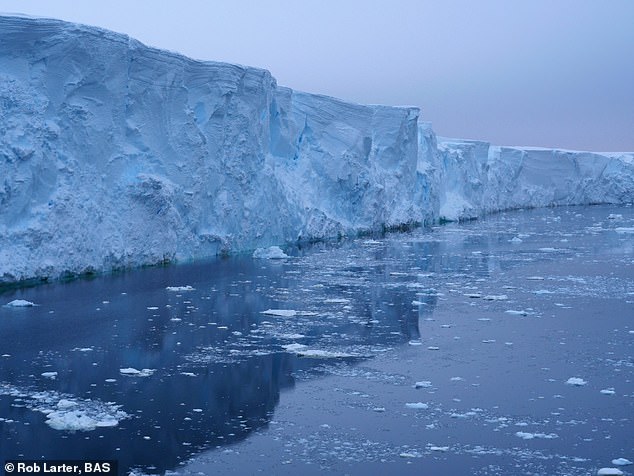
The massive surface of the Thwaites Glacier hides a thinning underside. John Moore from the University of Lapland wants to stop this thinning to save the glacier
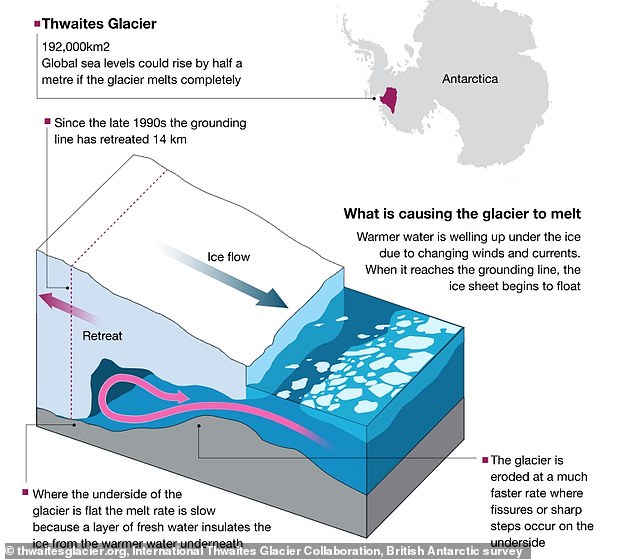
Warm water flowing under the Thwaites Glacier melts it. Once enough ice has disappeared from the bottom, the leading edge will flake off – or crack and fall off
Occasionally the glacier will calve – the scientific term for when a large chunk of the glacier falls off.
But this is just the obvious, outward sign of the much more serious problem of underwater melting.
Before the Industrial Revolution, when humans began spewing millions of tons of CO2 and other greenhouse gases into Earth’s atmosphere, Thwaites and other glaciers experienced normal cycles of thinning and thickening.
In winter the glacier would grow as the ice thickened, and in summer it would shrink as the ice thinned.
However, as the planet warms, there is much more thickening than thinning.
To some extent, this process would occur regardless of global warming, says John Moore, research professor of climate change at the Arctic Center of the University of Lapland in Finland.
But at some point the melting is just too much.
“Beyond the tipping point, glaciers like Thwaites simply collapse regardless of CO2 concentration, because the support they need to be stable disappears as the floating shelf thins, like kicking away a support holding up a fence,” he said to DailyMail.com.
“So if we want to replace the buttresses, we have to mimic nature and let the plank thicken back up and support itself,” Moore said. “The way to reduce the melting is to block some of the warm water that reaches it.”
This is where the curtain comes in.
They plan to anchor a curtain at the bottom of the Amundsen Sea, blocking undersea currents from hitting the underside of the Thwaites Glacier.
Held up by a floating top edge and anchored at the bottom, the curtain would float at the bottom of the ocean, invisible from the water’s surface.
Getting it into place without damaging the glacier won’t be a problem, Moore said.
“We would place the curtain far from the glacier and block the warm water in deep channels where they are narrow and accessible,” he said.
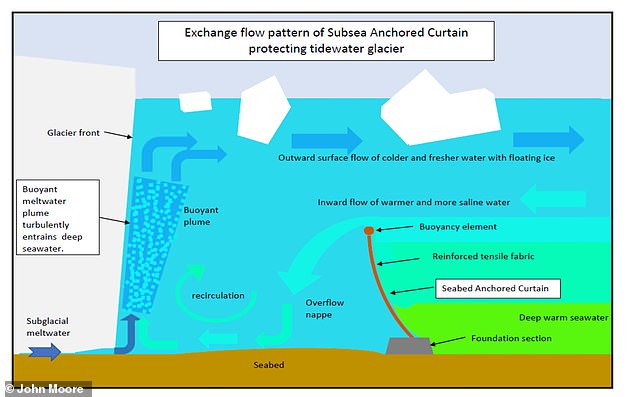
This image from John Moore and his team shows how the curtain would function. Deep, warm seawater (bottom right) flows toward the glacier, but the curtain would block most of it. However, some would flow over the top, where it would mix with the fresh water melting from the glacier (center). Then, instead of undermining the glacier, this mixed water would flow outward and away from the glacier (above right)
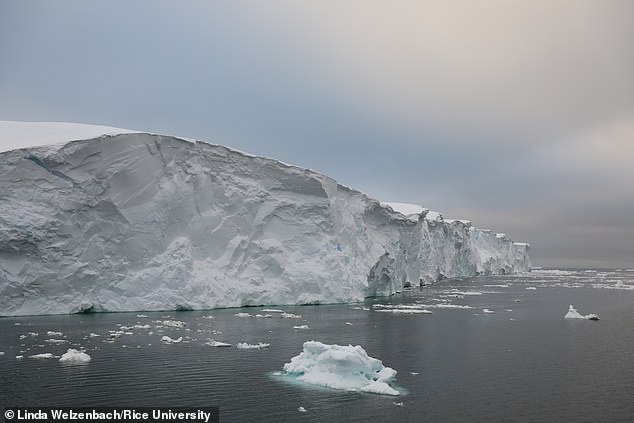
The Thwaites Glacier, on the western edge of Antarctica, is poised to raise sea levels by 3 meters if it melts completely
The biggest challenges, Moore said, are less about avoiding further damage to the glacier and more about the safety of the people hanging the curtain.
“The harsh conditions, the short working season with sufficient daylight and the danger of the many icebergs out there” are the biggest challenges, he said.
It will be years before they install the curtain, but Moore and his colleagues at the University of Cambridge are currently working on computer simulations to get the design right, as well as “a number of small-scale tank tests, mainly with aquariums.”
They then plan to install a prototype at the River Cam in Cambridge next summer.
“We also plan to test a range of ten different designs in the Norwegian fjord to see how they perform under realistic currents and wear,” he said.
‘If there are no serious problems later, we would try it on a fjord with glacial inflow in Spitsbergen.’
If all goes to plan, Moore and his team would see if the Greenlanders wanted to use them – and of course also see if a deal could be worked out to place the curtain in Antarctica to protect the Thwaites Glacier.
